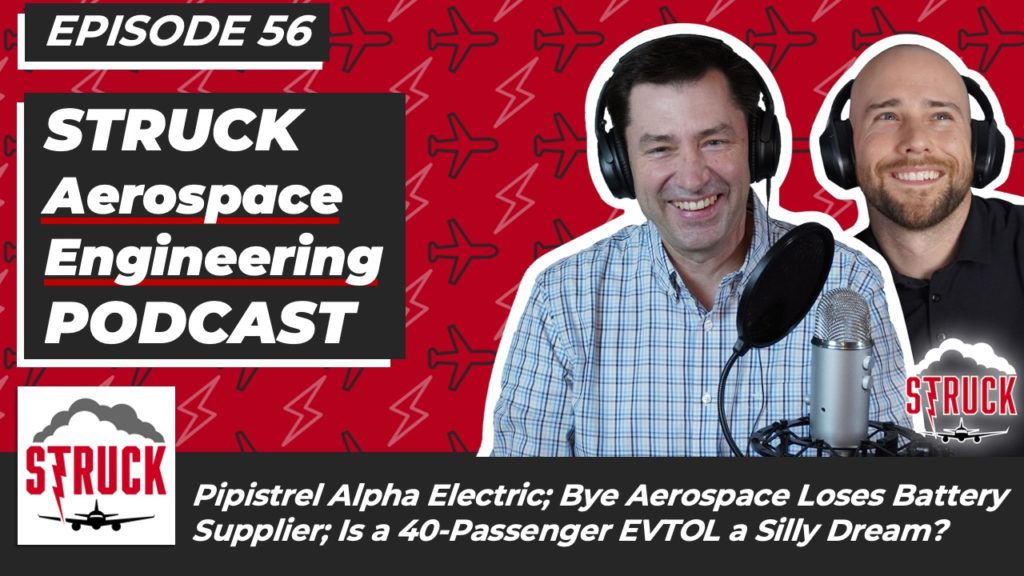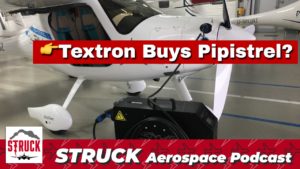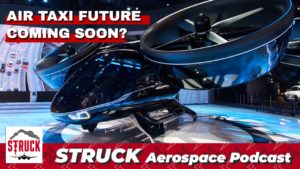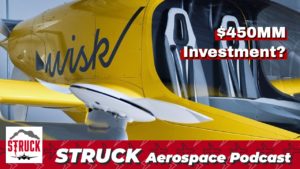Bye Aerospace lost their battery supplier, as Oxis Energy went into bankruptcy–what does this mean for Bye? We discuss the Alpha Electro, a trainer from Pipstrel, and the use of electric motors in light sport aircraft. Plus, more new EVTOL designs continue to pour out, including a 40-seat design. But are these prototype renderings just a pipe dream? Or will they ever actually fly?
Learn more about Weather Guard StrikeTape segmented lightning diverters and aircraft lightning protection consulting services. Follow the show on YouTube, Twitter, Linkedin and visit us on the web. Have a question we can answer on the show? Email us!
Podcast: Play in new window | Download
Transcript EP56 – Pipistrel Alpha Electro; Battery Woes for Bye Aerospace; Is a 40-Passenger EVTOL Just Science Fiction?
0:00
This episode is brought to you by Weather Guard Lightning Tech at Weather Guard. We support design engineers and make lightning protection easy.
You’re listening to the struck podcast. I’m Dan Blewett.
0:18
I’m Allen Hall.
0:19
And here on strike we talk about everything aviation, aerospace engineering and lightning protection.
Alright, welcome back to the struck aerospace engineering podcast. I’m your co host, Dan Blewett. On today’s show, lots to cover a lot of interesting news in the cycle this week. Number one, and we’ll chat about Southwest. There’s just way too many flight attendants getting getting punched in the face. So we got a we got a chat about it. EVTOL. Startup Archer is seeking to dismiss the trade secrets lawsuit filed by whisk but that doesn’t look like it’s going anywhere. That seems like it’s getting only increasingly messy. We’ll talk about mighty fly, which has been cleared to start autonomous cargo drone service. They’ve gotten some some clearance from the FAA, which will be cool. And then in our engineering Simon was about pipistrel. They’ve a light sport aircraft, they got an electric motor and about an hour of flight time with an hour charge time. So pretty cool. Some rough news for by aerospace, their battery supplier oxes energy is facing bankruptcy. So we’ll talk about the implications there. And then our EVTOL. Segment lots of interesting stuff going on there. We’ll talk about some certification issues, which we’ve talked a bunch about in the past ehang is unveiling a longer range design, and Kel akona has thrown out a 40 passenger concept, which seems straight out of science fiction at this point. And we’ll talk a little bit about that as well as some price controls. So start with Southwest isn’t really sad Southwest is calling off plans. Well, the plans to sell alcohol in the plains does not make me sad I I’m neutral to it. But there’s just been a lot of incidences with unruly passengers. And more recently, Southwest flight attendant was punched in the face loss of teeth. And I mean, things are getting are getting rough. What do you attribute this to?
2:18
Alcohol, alcohol, people being upset about masks, reconnecting with the rest of society after being disconnected for a year, all those all those things are playing into it. I recently flew to Las Vegas and I was I kind of like flying to Las Vegas, because it’s just it’s different places a little more activity. Most airports, the only place I guess there’s more places with slot machines. There’s a couple places with slot machines in the country. But that has to have the most. And the amount of alcohol there is says hi right You mean that people can leave in the casino gonna go home? For the most part and I think you see it in places where people have been partying in Florida had a rash of it. Some of the islands had a rash of it. I think that’s that’s just a big problem with alcohol. People being upset about mass people being overly sensitive about stuff and flight attendants worried about their well being which they have every right to it for a two hour flight. You’re going to get to a fistfight and punch somebody punch a flight attendant, which is a federal offense By the way, you’re not going to the county jail, you’re going to the your big old one of the big house under federal prison if they convict you and that’s not worth it. There’s no airline flight that’s worth that. Does that. Does that make any sense to me? Like, does anybody realize the consequences of that? Maybe they maybe they don’t maybe there’s just an Avery did enough. They don’t realize it.
3:53
I mean, he we haven’t heard that many physical like, this is a rare one the physical like this woman getting punched in the face. But I don’t know. I guess idiots can be idiots anywhere, including in the sky. People are just like less filtered about Yeah, what they’re not just not thinking. I don’t know. I don’t know. It’s well,
4:10
yep. He finds. Yeah, I think so. And the FAA has
4:14
taken a much more aggressive, really expensive fines like $50,000 I saw
4:18
for some passengers $10,000 here, $10,000 there and like a $10,000 fine from the FAA. They’re not kidding, right? When the feds do that and impose it and lock it in via some sort of court, finding your they’ll take it out of your paycheck forever, like that’s a debt that’s never going away. They will get that money or you’re going to jail and then that’s that’s what will happen in that in that outcome. And I it’s just not worth it. I know on some recent Southwest flights that I’ve taken, they’ve been trying to lower the temperature down a little bit and some of the initial everyone’s It’s cold. Yeah, yeah, that’s
4:58
true. Let’s fight. When there’s when they’re shooting when they’re shivering. It’s real hot in there. And that’s a very real thing. I mean, you wonder if this summer, the first summer back from COVID, where there’s still it’s still if you have masked here in DC, like some businesses allow them if your vaccines are allowed to mask if you’re vaccinated, many are still not many people are still wearing their masks despite being vaccinated and in a business that allows them to not wear one, which is baffling. But if it’s like 95 degrees, and people are angry about masks, and are just I don’t know, this summer could be like the summer of fistfights. Well, originally,
5:32
I hope not. Yeah.
5:33
Well, it doesn’t make you wonder because wasn’t the department transportation over the weekend, said they wanted people to wear masks on airplanes, just because it’s the right thing to do. Like, that’s not the reason why you wear a mask on an airplane, you’re wearing masks on an airplane because there is some health implications. Just like when we started it, there were some health indications want to make sure that wasn’t some sort of outbreak that was due to aircraft from people moving around. Awesome. But that is essentially over. At some point, you’re going to have to release that. Otherwise, you’re going to continue to have flight attendants assaulted. I mean, that’s the that is the reality of the situation, you will have flight attendants assaulted and it it the the penalty for it is not connecting to some random person who doesn’t read the FAA website about the fines and maybe has a drink before they get on the airplane whammo. those situations can escalate so fast that you just feel bad for the flight attendants who are stuck in the middle. I mean, they got to employers telling them one thing, they got the FAA it’s telling them you got to do these certain things and you got passengers that are tired of it to inevitable.
6:42
We were all tired of it. But be nice to your flight attendants everyone. Yeah, come on. So mighty fly has gotten FAA approval to start doing some tests test flights with its hybrid electric autonomous cargo e VTOL. Aircraft quite a mouthful. Good reporting from future flights out arrow. But they’re going to be seeing if they can deliver these these reasonable payloads, you know, maybe 100 pounds here, they’re up to 600 miles. Alan, what what what is what is what’s unique about this little special airworthiness certificate?
7:21
Well, it’s it’s part of a program that FAA started a couple of years ago, to apply what they call part 135. Regulations was calling conditions of operating a pay for to pay pay for flight like a air carrier kind of thing. Which has never been envisioned, in a sense in the regulations of the pilotless aircraft. It’s not necessarily pilotless as there’s not somebody on the ground controlling it, but there’s not somebody in the craft and the aircraft. That’s the difference. Now, when I looked at when you, when I looked at the pictures online, you’re like, this is not your average drone. Like this is the size of a small car. It’s it’s decent size, anything less 100 pounds and go 600 miles is going to be big. And I understand the rationale why we want to do this, but I don’t understand the rationale why we want to do this like what what Can’t we carry right now? airport to airport? on an aircraft? I mean, even if it was even if it’s a pile unpiloted drone thing? Is it. attempt. This is what I was reading through this is the attempt to basically drop cargo in some random place as needed. And not actually go to an airport and land the thing that bothers me. That part bothers me because the most critical part of any flight is landing, or in some case, deploying cargo. And when something goes wrong there, I’m not sure what, how great that’s going to be in terms of people on the ground and property on the ground and what it looks like. Because Can you imagine Daniel order some 99 pound Amazon product, and it comes delivered to your front door? I don’t know how that works. I don’t know how that
9:22
works. 200 297 boxes of macaroni and cheese was a discount from Amazon. delivered to my door looks like. Yeah.
9:31
What’s the economics of that? I don’t think that makes any sense economically to do that when they have the postal trucks going by your place every day anyway. I don’t know that makes a lot of sense. And the downside risk is as this craft falls out of the sky or hit something or runs into something in pool,
9:51
well, I feel like it kind of goes back to your point there. I feel like it kind of goes back to the idea of whole truckload versus the small shipments right like If you can ship a whole truckload of something becomes way more economical than shipping one off, right? There’s a apps it was something was I reading something about a carpet manufacturer, they were trying to become more eco friendly. And they were trying to recycle their carpet, but like taking someone like tearing carpet out of a commercial building, and shipping it back to their factory was just super duper expensive. So they started to create caches, where like, you could have a local warehouse until it got to a full truckload of this used old carpet. Oh, then they could pick up a whole truckload and then it made economic sense. Sure. Oh, you know, that kind of just was in my head, as you’re just talking now about the economics of these little a very high tech small shipments. Like you said, if you can throw all these packages on one UPS truck, how is that not more economical? I don’t know. Probably not as fast depending on, you know, whatever. But yeah,
10:56
I get the one though. There’s was one drone services operating in North Carolina in some mining conditions where they wanted to move equipment, like across a mountaintop, to get from one mind site to the other mind site. That totally makes sense to me, right? I mean, that that that’s not it’s in a rural area, you got equipment, that’s very difficult to get from A to B, because there’s a mountain in the way and you can just basically jump over the mountain with the drone. Okay, but delivering macaroni cheese makes no sense. No one’s gonna. It’s just, I just don’t see it.
11:29
That’s what I want. Okay.
11:35
Well, whatever Jeff Bezos can deliver. It will be you know, authorized, I guess we’ll see.
11:48
So moving on to our engineering segment, let’s talk about conventional takeoff airplanes, we, there’s just so much news about the new VTOL sector, it’s just everywhere. But today, let’s talk about the alpha electro, which is a light sport aircraft from Pipistrel. It’s got an hour about an hour flight time, and it only takes about an hour to charge, which is pretty cool. And so this is another one of those, you know, new technologies, using electric motors, you know, pretty well, pretty efficiently. And that seems reasonable that if you’re training a new pilot, even being on the ground for an hour to recharge doesn’t seem like a big deal, as you’re probably getting ready for the next next student, and, you know, going through some checks and all that stuff. And of course, obviously, the battery technology will increase and increase that flight time over time. But I mean, Alan, you Where do you fall on this use for light sport aircraft? Because I know you have some concerns about weight, as they’re already really light. And I mean, hence the name. But heaviness and the weight has something to do with the the safety of the aircraft, doesn’t it?
12:52
Yeah, the accident rate for light sport aircraft is not very good. And and the thought was that taking some of the more restrictive regulations weighing simplifying, the the approval process for light sport aircraft, would open up a whole new marketplace, for less expensive aircraft, that hasn’t happened in the way they envisioned it. aircraft are still expensive. And when I say expensive, like the price of a house is expensive. So an aircraft just expensive to make, period. Let’s get that on the table. The other part about light sport aircraft, from a safety standpoint is that they’re light and they get tossed around a good bit. And I think that has something to do with the accident rate that they’ve seen, because you still have a lot of mass there. But I think the concept is right, I think the electric concept, the battery concept. And the recharge capability is right, the operating costs are way lower because of the electric motor and the battery just for simplicity standpoint, it’s just a lot less take care of. So if you if you have a training facility, and you want to keep your operating costs low, that’s how you do it. You start putting electric aircraft in there, because you’re not going very far. Yeah. And it’s functionally training. Ron, you’re just not. And that’s, that’s sort of the perfect marketplace. I brought that discussion. from a marketing standpoint, you want to niche down and find that sweet spot where your product works, and you can be the expert in that one thing. Well, Pipistrel is kind of starting to own that space a little bit. Because of the technology they’re bringing forth and the electric aspects and lowering your operating costs and doing all these other things. I think it’s a cool airplane. I think they’re gonna be successful with it. They already are successful with it, because you see it being shown in multiple different countries, you see a lot of interest in it. It’s gonna stick around for a little while. It looks like
14:41
yeah, and what I thought was cool as I watched a YouTube video about it is that you know, because it’s electric, like the torque curve is so fast that it’s getting up to speed and take off like really, really fast. Yeah, which is the same thing with like Tesla automobiles. I mean, they’re so fast because you put the guy you put the accelerator pedal down, not the gas pedal, and it’s just like All the all the engines power is there immediately. So instantaneous scoring? Yeah, infinite torque. Yeah, that’s
15:06
the beautiful thing about electric motors. Yeah, no, but I think it’s also gonna take some time for pilots to get used to you to that effect. A lot of a lot of engines take time to spool up, they’re not instantaneous. And an electric aircraft, you can get away with a lot more. No, there’s other things that you want to worry about is like carburetor icing, and all the all the associated problem, failure modes that occur with a piston engine, go away with electric and if you you will, at some point in the goal is to transition up to a larger aircraft for most pilots is to move up to a larger single into a twin. You have to learn those other skill sets because electric aircraft is really simple to operate, which makes it great for a trainer, but not necessarily great for moving into like the twin world yet.
15:54
Yeah, well, speaking of twin engine oxus energy, which was the battery supplier of lithium sulfur batteries for all different applications is facing bankruptcy, which is unfortunate for the buyer space, ie flyer 800, which is the eight seat electric, dual prop plane that buyer space is developing. I mean, do you feel like this is gonna be a quick, you know, just grab another supplier? I mean, I think the one positive for buyers that there’s a lot of battery power needs in the world at the moment. So I’m sure there’s someone else out there, right? Maybe? Or is this going to be a problem for them,
16:33
the software part of that battery was the trick. And I think that was going to increase the energy density by roughly a factor of two. So that was the whole value to that battery system. And why that was chosen is it’s all about energy density and weight, right. So you can get more energy packed in that same amount of volume, then it works great for airplanes. And if you’re, if you’re trying to make a twin engine aircraft, like a King Air, you’re going to need a lot of energy to make it go far. So the pairing up of buy and oxus made a lot of sense at the time. But it’s starting to feel a little bit like access knew this was coming. So the most the most valuable time when most of the time to extract the most value for your company, in an aircraft environment is to get an aircraft design wrapped around you then say you’re going to file bankruptcy, because the aircraft manufacturer feels like they’re getting stuck right there. No, they’re in a really bad position. And that maybe they’ll buy you and may overpay for you. Because the option which oxus is trying right now. And what you hear a lot of reports is is that they’re offering all their patents for sale. Now you haven’t heard anybody buying them, but they’re going to offer them for sale. And if you’re if you’re by you’re going to have to worry about that like well, maybe Textron buys all their patents, and I can’t, I don’t have my batteries for my airplanes anymore, which Textron could do, right been touched on could really, at this point, put a big dent, and eight seat twin that by wants to make. So there’s a lot of that business aspect. And as engineers, you don’t want to think about those avenues that happen. But it’s still within a day, it’s still business. And if oxus thinks they can get a big value for their Corporation, or get cash out of it, and cease operations. So if that’s the right financial thing to do, then maybe that’s the right thing to do for that company, but it does have ramifications much larger than their company. It does. And that’s how you see it in aerospace quite a bit, you get a supplier locked in, and then they you know, they they try to leverage it for for cash so they don’t go bankrupt. And it’s always been in that situation number of times over the years and it just turns ugly, there’s really no good outcome of that Boeing at times has taken over companies so to keep them out of bankruptcy and then continue making parts so that airplanes to run on production line. But you don’t want to be doing that if you’re if you’re a small Aircraft Company, you don’t have the people to do that. So it does it does hurt you know schedules on with buy on the twin it’s gonna it has to, it has to, which is a shame because I think there’s a lot of great things going on a buy right now. There really are the the trainer, the two seat and a four seat trainer make total sense. And I think those are planes are gonna be great airplanes once I get them out and delivered.
19:33
Well, and one of the things that buyer was looking towards was that 550 watt hours per kilogram density that oxus was hoping to get to by 2023. And this was a good article about this on a VTOL calm. And so now I guess the you know, like you said they’ve got to re re steer the ship and figure out where they can maybe get that future energy density, because it doesn’t sound like that’s on the market. You know, the way that they’re trying to develop that then that’s I think the big challenges companies are trying to get ahead of that and say, okay, we want this target in the future, what companies are doing that, but if they’re startups, they’re just going to be subject to this riskier environment where? Yeah, they will have a lot of orders. They’re developing a lot of new technology, they’ve done a lot of research, they need a lot of investment money without a lot of orders coming in. And that’s that trembling. I don’t know that. It’s difficult.
20:24
Yeah. And, Dan, it’s very similar to if you see, there’s been a lot of piston engines being built for smaller part 23 aircraft over a number of years, and how unsuccessful those programs have been on a just a standard internal combustion engine, where they just don’t make it right. And why would electric motors and batteries be really any different than the internal combustion engine, which we’ve known for 100 plus years, how to make work. All the time, new engine programs come to engine programs go and you just scratch your head, like I don’t know why they couldn’t get this motor to work. And I think the same thing exists here. The problem for an aircraft manufacturer is sort of twofold. Whoa, though, right now, before you got fuel liquid fuel, which you can buy any airport anywhere, so that that problem is solved on a typical internal combustion engine, it’s just the motor part, you got to go figure out electric you got to get the batteries and the power plant the electric motor, you got two big problems Seto just the motor problem. And that is sort it adds the level of complexity and difficult to the engineering staff is what it does.
21:38
So let’s move on to our VTOL segment today. First, let’s talk about certification. So, Ellen, there’s a good article from aviation today.com just talking about where some of these companies are Joby aviation, is one of the first they got military airworthiness or air worthiness from the AF works agility prime program. That’s still a far shot from FAA certification. You know, we’ll spend a couple minutes here, but you know, what are the what are the big keys here? Because it you know, this article says that, you know, Archer, for example, will use a blend of current FAA part 20 320-733-3536 requirements. That sounds I don’t know what that means. But that sounds complicated.
22:24
Yeah, impressive, right. Yeah.
22:25
Yeah. So take us through some of the hurdles here.
22:28
Oh.
22:30
I mean, just all all the hurdles. Alan has Well, in this book, there’s, well, I
22:34
think there’s, I think in the veto market, there are so many that it’s gets hard to even break it down into bite sized pieces. And I think, as engineers, one of the first things they teach in engineering school, want to do your homework and to is to break down problems into bite sized pieces. So you can solve each part without having to solve the whole thing at one time. And the problem right now, for a lot of evil AV tools is that they have 23 part 23 part 27 powerplant propellers so they are touching all these different areas that a typical Aircraft Company like Textron won’t touch, like Textron doesn’t make props or hasn’t made props in a long time. Textron doesn’t make motors, at least, like an assessment of the beach lines, they don’t they buy them, right. So there’s two of those off the table, they just buy a component. And now the Beatles got two more laughters, which is that it’s part helicopter part aircraft. And so you got two sets of regulations, one for aircraft, one for rotorcraft, that you have to meld together to make this set of regulations or requirements for this aircraft, which really no one has ever done before. So, so a lot of sometimes those those regulations don’t necessarily jive the way you think they would, there’s got to be some interpretation to them, there’s going to be some learning goes on, but it’s just a massive amount of complexity you’ve added to it because, in my opinion, because of the vertical part, the vertical part adds a lot of cost and complexity, weight costs, material costs, you name it, it’s adding a lot of complexity to the aircraft. Were like a bio space doesn’t have to do that buys gonna buy a propeller, I think seems like it and they’re clearly buying saffron motors. And that’s, that’s been announced multiple times. They’re just building an airframe. So by just building an airframe, a part 23 airplane, once you’ve been part building part 23 airplanes for years. So by has a much smaller bite size problem to work on. Versus Joby, which has multiple problems to work on. That’s the difference. And so from an engineering standpoint, you need to look at how many my opinion you need. Look how many people are on staff to solve those problems because everybody’s working on the bite sized chunk. That’s only so many people working in bite sized chunks need a lot of people tuned a lot of time. So the, the amount, the amount of overhead amount of people at Adobe ought to be two to three times as many people as it is it by has to be to make it go. Well, let’s
25:14
stick with this this line here. So as far as engineering and trade secret SCO there’s a pretty contentious lawsuit right now between whisk and Archer course what lawsuit is not contentious, but this one is getting? It seems a little messier. The FBI is involved. Archer is saying which I feel like this word is used in every lawsuit which is baseless. There were just calls them Oh, this lawsuit against me is baseless. Well, some of them are but this one seems like it’s not going anywhere, any soon. or anywhere any anytime soon. It seems like it’s only heating up. Alan, what are some of the without getting into specifics? Because there isn’t that much known. There’s definitely some similarity, which is what Wes was claiming when some of their many of their engineers were hired to go work for Archer, you can definitely see some of the design potentially incorporated with with archers, aircraft. But what’s that? What’s the big Code of Conduct here for engineers? I mean, you’re an aerospace space engineer. What would you what would what warnings and what Code of Conduct would you share with a young engineer to not end up in a situation where they might be in trouble
26:27
doing something like this, in today’s world, when you sign on to a company to work for them, as an engineer, there’s rarely a case in which you’re not signing a confidentiality nondisclosure agreement that lasts for years after you leave the company, if they’re smart, and they may may have to sign a non compete or non competes tended to be back in the 90s, not so much today, where you couldn’t work for a competitor for a year. So basically, you couldn’t eat for a year, or make or couldn’t work in a similar industry, because everybody’s a competitor in airplanes who’s not. So you’d have to go homeless for a year, while the clock ticks away. You as an engineer, I have to make really good decisions here. If you’re signing that nondisclosure, that means they’re gonna hold your feet to the fire. And there’s some corporate lawyer who’s who works for that corporate works for the company who’s going to come after your rear end, if you decide to, in theory, take things out, that belong to the company, they’re paying you not to do that. And that’s the that’s the company rationale is like, I’m paying you not to steal our stuff. Don’t steal our stuff. And as an engineering, like, Well, you know, there’s a fuzzy line between what’s yours and what’s my intellectual property, it’s my head, I own I own what’s inside my skull. You don’t own that. Right? And what was it? Well, everything you wrote down, everything is written down or on a computer somewhere, without any sort of public information you made and a meeting or whatever they own. So you have to know that and as you get older and more experienced, and you’re coming through the ranks of stuff, you have to realize there’s a point at which maybe the compensation you’re getting for the ideas you’re creating isn’t compatible with you anymore. So you have two choices. Swallow it, give them the give you a company that’s paying you a weekly salary, give them the idea and move on, let it go. Or if you think the idea is so grandiose and worth so much money, that you’re going to set the world on fire, then you better shut up, and not tell anybody about it. And leave, give it a couple of weeks, start your own company go work for somebody else who’s going to pay for what that idea is worth, those are your options, what your options are not is downloading a bunch of documents off of off of this company a and then going to work for Company B and loaded giving them all the information. Now Company B ought to be smart enough and have corporate attorneys to to say, you can’t do that we’re not looking at that stuff, and you’re fired. Get out now, like, you got to go right now. Because you’re gonna get sued, and rightly so you’re gonna you’re gonna get sued. But engineers get this weird place where their intellectual property, what’s in their head, what they consider intellectual property, because it’s me shouldn’t get abused. If I’m working for a company that doesn’t. Maybe the idea is not getting promoted or that the company does have the money to invest this properly and you feel like your ideas is withering on the vine. You have this gumption like well screw it, I’m going to the next company and take this great idea and I’m going to get paid for it. It’s too late. It’s just too late. You can’t use it. Just can’t do that because Company A is going to Company B, and you’re going to be the middle of it and amount of happiness a company or Company B, you’re going to be unemployed and not only going to be unemployed from Company A and Company B, pretty much companies C, D, E, and F and G are never going to hire you because you what you did there. So it’s a good lesson for anybody it is to not do that and to figure out, get an attorney, get honestly swear to swear to God, if you think you’re in that situation, get yourself an attorney, and talk it out with somebody who knows what they’re talking about, and what that corporate law is and what you’re allowed to do and what you’re not allowed to do. I did that early in my career, that was probably one of the best $200 ever spent. If you have a great idea, and you don’t think their company you’re working for is going to have any value in it. Don’t quit, quit, quit, don’t tell them about it quit, move on to someplace else. And I think that’s a much more valuable experience and knowledge to have somebody on the outside rather than you or your spouse or whoever your friends giving you advice. You better get an attorney, someone who knows what about corporate law and how you’re gonna get sued and get it figured out before you decide to walk out of a company? Because it’s that struggle.
31:16
Yeah, well, we’ll see how this story progresses. You know, both sides are debating the facts. And we’ll see what comes comes down to the air. Yeah. So last on the docket today. We’ll go home. We won’t go into detail on the one but he hangs got a long range. It’s there, VT 30 A VTOL. Design. Still pretty preliminary, but they’re already looking at a longer, longer flight. Or just more more passengers in general. Right. more passengers. Yeah, this is still actually going to be pretty short. So maybe a 35 kilometer 2022 ish mile range. So yeah, I mean, they’re still building off the thing. They’re still I guess kicking after the, you know, the stock turmoil handful of months ago. They’re still plugging along. The other thing that’s I find is interesting here is this company called Kela. Kona is just sharing their prototype sketches of a 40 seater, a VTOL aircraft that looks like a flying manatee. With ducted ducted fans. I mean, it’s just that’s what it looks like. No, get around it. So while most VTOL companies are struggling to make this work with two seats, or four seats, this company is like, Hey, we’re gonna do 40 like, move on over everyone. I mean, Alan is this is his This is how outlandish as it sounds.
32:45
Yes. It is. Really the image the images and like you’re in this can looks like a an airfoil with no tail on it. No, no empanadas on it at all. And a bunch of ducted fans is providing all the directional thrust. And I think that’s just not going to happen. I don’t know how to describe it. That’s not gonna happen. You’re not going to get 40 people to get inside this enclosure. I’ll call it, you’re not going to be able to certify it. It’s not going to everything about the physics of this says no. And also the human response to it and human emotion to it. It’s going to say no. So why are we pursuing this? And why are people I guess we got to fill space on the internet. There was a slot on the night available. For some crazy airplane, right? This is, this is the day is every Thursday, we got to put another crazier and that’s crazy, but like a maybe unrealizable airplane design out there and, and keep all the readers interested. This is another one and every it seems like now It used to be they were like nuclear powered aircraft that we’re gonna go Mach five, and then then it transitioned into super efficient big jet engines, and then we transitioned into electric and then it ceased to like fluctuate, and then the solar powered airplanes and the whole thing. So because of this, like gyration thing where it’s like the old Popular Mechanics of days gone by, which was, you know, they’d have stories that would just not, there’s no way this thing’s gonna come to fruition, but it sparked interest and keep creativity happen. I think when you see designs like this, it’s like, oh, well, you know, okay. I mean, there’s some Oh, that’s Yeah, right. Yeah. Right. And that you don’t say to yourself, man, I gotta call my stockbroker and invest in that airplane. Don’t do that. No, no, no, don’t do that. That’s exactly the opposite of what you want to do. You want to hold your cash and these situations, but I think from from an engineer standpoint, you’re like, Oh, come on, you know. Now No, no. And maybe they you know, prove me wrong. It’s like we’re talking about maybe we need to have a predictions part of this of the of the podcast for on the airplane side where you say yes or no. And we like put it into the envelope and a year for now we open it up and go, okay, Alan was right 62%
35:18
of the time and yeah, time capsule.
35:22
It feels like it because it’s so wild right now. That, you know, it’s just like, you know, Tesla five years ago, like, Oh, yeah, maybe they won’t make it worse, you know, all the starship stuff that Musk is doing, like, oh, there’s no way to pull it off. But I do feel like we’re in this weird prediction mode. And we we should do something like that. It’d be fun.
35:48
Well, it’s just, uh, you know, again, seeing all the struggles that companies are having to put their aircraft in the air with just two seats, and then to see this 40 seater, and then to look at the company’s website and see no known faces on their about page. There’s no people listed there. There’s no head engineer. It’s unclear, like what this is, I mean, who are these people? I don’t know, how much money has any money been invested in this? Those are also unanswered questions. I couldn’t find any.
36:17
That’s a really good point. Right? Very good point. Is it a SPAC play?
36:22
it could just be a graphic designer made some renderings of a plane, and they made a website and said, we’re gonna do 40 seats. And that’s as far as they’ve gotten. We don’t we don’t know. I mean, I mean, good luck, and Godspeed. But there’s not a lot of information besides the renderings and what they hope to have happen.
36:40
Well, you know, you know, over the pandemic time, I was reading a really interesting couple of articles talking about the evolution to spec and how that structure is set up, where it’s like going to Vegas. So there’s been a lot of specs it up. And but you know, they go live for a certain amount of time. And you’re never sure which one’s going to be the one that hooks up with a corporation as a possibility of making a big, big product. He kind of wonder if like, a lot of if you want to tap the spec environment right now, that would be the way to do it. Like, Oh, I got a spec to invest $100 million, which we’re never going to spend, but it can keep me in you know, nice lunches in an office for the next year or two. That’s that’s what it seems like. It doesn’t seem like there’s a financial keen financial sense that goes along with the engineering and some of these projects where they’re going to really come about and and make something of it.
37:46
Yeah, we’ll see. But you’re right. It’s a it’s kind of wild west of designs and new things. And like you said, it’s probably good just to get the creativity flowing. But who knows if we’ll ever see the this this design come to fruition. So that’s it for this week’s episode of The struck aerospace engineering podcast. Thanks so much for listening. Be sure to subscribe on YouTube, iTunes, Spotify, Stitcher, wherever you listen to podcasts, and share the show with a friend. leave us a review. We’d appreciate it. And we will see you here next week on the struck podcast.
StrikeTape Weather Guard Lightning Tech proprietary lightning protection for Radome provides unmatched durability for years to come. If you need help with your radon lightning protection, reach out to us at weatherguardaero.com that’s Weather Guard a e r o.com.












